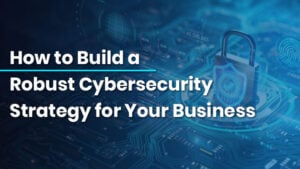
Google Workspace vs. Microsoft 365: Which is Better for Your Team?
Google Workspace vs. Microsoft 365: Which is Better for Your Team? Introduction Choosing the right productivity suite is essential for any business aiming to
🔥 Limited Time Offer 🔥 Get the Premium Monthly Plan for just $11.99 $19.99. Use code UPSKILLNOW and unlock exclusive benefits 👉Subscribe Now!

Google Workspace vs. Microsoft 365: Which is Better for Your Team? Introduction Choosing the right productivity suite is essential for any business aiming to

How to Build a Robust Cybersecurity Strategy for Your Business Introduction In the modern digital landscape, cybersecurity is no longer just an IT concern,

What Does It Mean to Humanize Healthcare AI? Introduction The emergence of Artificial Intelligence (AI) in medicine is revolutionizing the sector at an unprecedented
Table of Contents
AWS is a cloud computing platform that offers users a wide range of tools and services. Amazon, the company behind AWS, is one of the largest technology companies in the world. AWS is used by businesses of all sizes, from small startups to large enterprises. AWS offers a pay-as-you-go pricing model, meaning you only pay for the resources you use. AWS also has a free tier, which gives new users access to some AWS services at no cost. AWS constantly adds new features and services, so there is always something new to learn.
AWS is an essential tool for any business that wants to scale its operations and grow its customer base. With AWS, you can run your business more efficiently and connect with more customers than ever.
It is critical for any business to have a stable AWS environment. There are many moving parts to an AWS environment, and if any of them are not configured correctly, it can lead to significant problems.
If you are interested in beginning your career in AWS, IPSpecialist is considered the best place to start your journey. Check out our AWS Courses now!
This article will help you to understand and apply some tips for a more stable AWS environment:
Although third parties do not adhere to the same security standards as you and are more challenging to monitor and track, they render your environment susceptible.
Working with third-party vendors is inevitable; therefore, by taking the actions listed below, you may reduce third-party risk in your AWS environment while allowing your business to run normally.
Be cautious while configuring policies, and ensure you know the rights’ scope. Give your suppliers only the permissions necessary to execute their jobs, adhering to the principle of least privilege. Do not automatically grant permissions that your vendors want you to give them. If not, your vendor might have access to confidential data or be able to take various unsafe actions.
A collection of permissions assigned to a principle (such as an IAM user or role) that establishes limits on the actions the principal is permitted to take is known as a permission boundary. To limit the actions that third-party roles can take outside of what is permitted by policy permissions, add permissions boundaries to them.
IAM policy configuration for AWS services is challenging. The configuration process is exceedingly difficult to finish because it is frequently impossible to know at the moment which permissions are necessary for whatever user and service.
Additionally, not many solutions allow for the analysis of rights granted, comparison of those granted to those used, and subsequent right-sizing of roles to achieve the least privilege.
However, you are frequently expected to get started right away rather than letting cloud administrators and DevSecOps take the time to manage, construct, and set up IAM roles effectively. As a result, you might be using short-term solutions to manage roles and permissions.
It is typically unknown which permissions are necessary for which user or service when configuring IAM policies. AWS-managed policies are helpful in this situation. IAM policies managed, regulated, and upheld by AWS are AWS-managed policies. They give a template policy that AWS manages based on typical use cases.
The complicated and challenging process of designing, managing, and maintaining authorization policies is saved by this solution designed for administrators and DevSecOps.
However, relying solely on AWS-managed policies is risky in the long run. These policies typically grant overly broad permissions, putting your cloud environment in danger.
Enterprises frequently regulate their cloud identities to comply with regulations and reduce security concerns. Separating compliance and security, however, frequently results in using two different providers and failing to adhere to existing cloud security standards. When compliance and security are viewed as two sides of the same coin, a single solution can provide identity management, which offers identification, visibility, reporting, and remediation of risky entitlements. For reliable cloud security, this is the best option.
Organizations are at risk from excessive permissions because they raise the possibility of a purposeful or unintentional data leak. You can discover and reduce risks by limiting permissions following the principle of least privilege.
The least privilege concept must be implemented to ensure that the danger to cloud security is kept to a minimum. However, because environments in AWS are so volatile and configuration is so complex, achieving the least privilege is difficult. Here are some helpful AWS tools:
A system allows users to define the resources an identity may access and the actions that identity is permitted to take on those resources.
A restriction on permissions at the account level.
A device for testing the effectiveness of policies implemented about an AWS identity, service, and resource.
A tool lets you see the dates and times each AWS service is accessed on each identity.
A tool that allows you to detect access granted to external identities by resource-based policies, it is used to analyze access to resources in your account.
While securing the AWS Environment, it is also necessary to secure the AWS Infrastructure. The following are some tips to secure AWS Infrastructure.
The best method for securing AWS infrastructure, especially the networking architecture, is frequently regarded as layering security. A layered network security solution can be made using firewall rules, Amazon VPC, network access control lists, and security groups in the cloud. Your data will be more securely protected due to these threat protection layers.
There should be frequent and regular backups. If you do not make regular backups, an unforeseen incident like database corruption, data deletion by accident, or a natural disaster could cause you to lose a significant amount of data. Data duplication from backups only increases redundancy. To consolidate and streamline the process, use AWS Backup.
Amazon’s Virtual Private Cloud (VPC) service offers a secure space cut off from other users. Additionally, it offers layer 3 internet isolation. You can secure the integration of VPC IPsec with your VPC resources.
DNS plays a significant role in your infrastructure, making it a crucial component of any security management strategy. Malicious parties can intercept the DNS client traffic if your DNS systems are not secure.
A DoS or Distributed Denial of Service (DDoS) attack could harm companies offering online applications. It is critical to lower these hazards. One method to achieve this is to reduce the potential attack surface. To achieve this, you can position your resources in front of load balancers or Content Distribution Networks (CDNs). You can limit direct access to your database servers in this manner. To defend against specific attacks like cross-site requests or SQL injections, you can also utilize a Web Application Firewall (WAF).
To have secure cloud resources, IAM is the first step. You can adhere to standards like using secure passwords and two-factor authentication. Additionally, timely audits will enable you to eliminate unneeded credentials and lower the risk of a security attack. You can create your own policies or use AWS-defined policies, which are created in compliance with standard IT functions.
AWS provides various tools to help organizations secure their cloud environment. However, AWS environments are complex and constantly changing, making it challenging to achieve the least privilege. As a result, enterprises should consider using a tool that can help them detect and remediate risky entitlements. Additionally, organizations should view compliance and security as two sides of the same coin and use a single solution to manage both. Doing so will help organizations adhere to security standards while meeting compliance requirements.
© 2025 All rights reserved | Privacy Policy | Terms and Conditions | Sitemap | Cookie Policy




